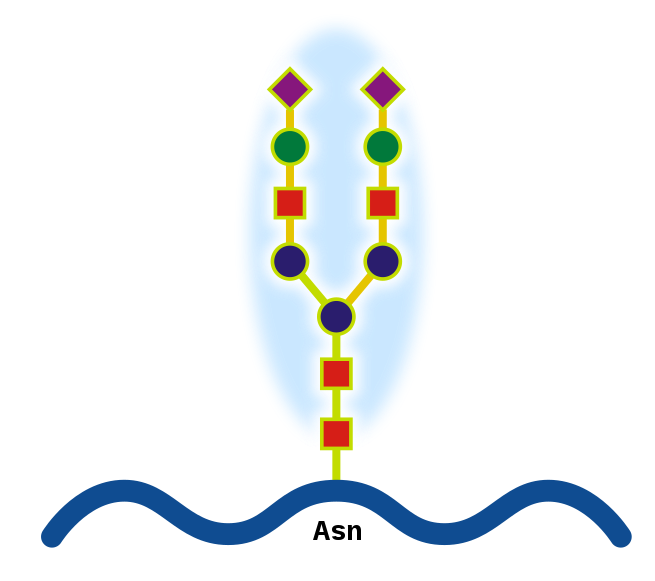
-
Proteoglycans
Proteoglycans are proteins that are heavily glycosylated. The basic proteoglycan unit consists of a “core protein” with one or more covalently attached glycosaminoglycan (GAG) chain(s). The point of attachment is a serine (Ser) residue to which the glycosaminoglycan is joined through a tetrasaccharide bridge (e.g. chondroitin sulfate-GlcA-Gal-Gal-Xyl-PROTEIN). The Ser residue is generally in the sequence -Ser-Gly-X-Gly- (where X can be any amino acid residue but proline), although not every protein with this sequence has an attached glycosaminoglycan. The chains are long, linear carbohydrate polymers that are negatively charged under physiological conditions due to the occurrence of sulfate and uronic acid groups. Proteoglycans occur in the connective tissue.
-
Glycoprotein
Glycoproteins are proteins that contain oligosaccharide chains (glycans) covalently attached to amino acid side-chains. The carbohydrate is attached to the protein in a cotranslational or posttranslational modification. This process is known as glycosylation. Secreted extracellular proteins are often glycosylated.
In proteins that have segments extending extracellularly, the extracellular segments are also often glycosylated. Glycoproteins are also often important integral membrane proteins, where they play a role in cell–cell interactions. It is important to distinguish endoplasmic reticulum-based glycosylation of the secretory system from reversible cytosolic-nuclear glycosylation. Glycoproteins of the cytosol and nucleus can be modified through the reversible addition of a single GlcNAc residue that is considered reciprocal to phosphorylation and the functions of these are likely to be additional regulatory mechanism that controls phosphorylation-based signalling. In contrast, classical secretory glycosylation can be structurally essential. For example, inhibition of asparagine-linked, i.e. N-linked, glycosylation can prevent proper glycoprotein folding and full inhibition can be toxic to an individual cell. In contrast, perturbation of glycan processing (enzymatic removal/addition of carbohydrate residues to the glycan), which occurs in both the endoplastic reticulum and Golgi apparatus, is dispensable for isolated cells (as evidence by survival with glycosides inhibitors) but can lead to human disease (congenital disorders of glycosylation) and can be lethal in animal models. It is therefore likely that the fine processing of glycans is important for endogenous functionality, such as cell trafficking, but that this is likely to have been secondary to its role in host-pathogen interactions. A famous example of this latter effect is the ABO blood group system.
-
Proteoglycans (noun)
plural of proteoglycan
-
Glycoprotein (noun)
A protein with covalently bonded carbohydrates.
-
Glycoprotein (noun)
any of a class of proteins which have carbohydrate groups attached to the polypeptide chain.
